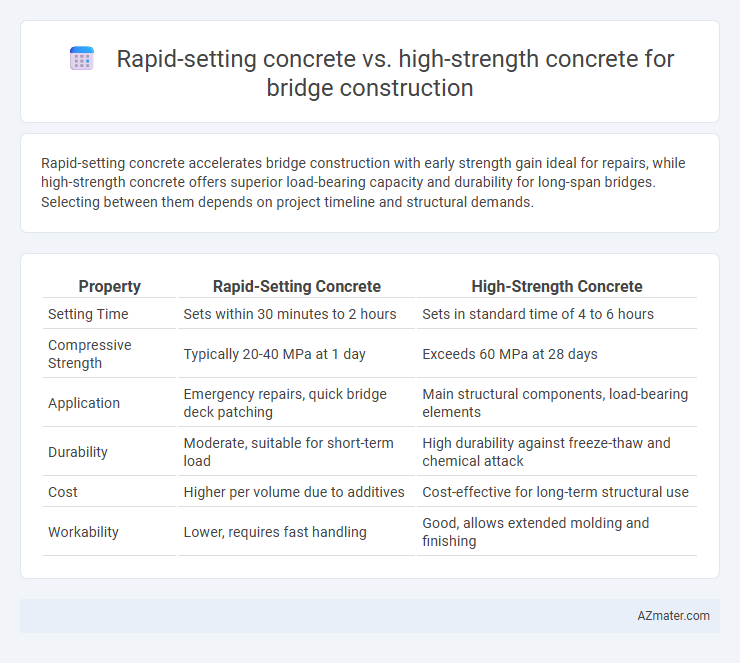Rapid-setting concrete accelerates bridge construction with early strength gain ideal for repairs, while high-strength concrete offers superior load-bearing capacity and durability for long-span bridges. Selecting between them depends on project timeline and structural demands.
Table of Comparison
| Property | Rapid-Setting Concrete | High-Strength Concrete |
|---|---|---|
| Setting Time | Sets within 30 minutes to 2 hours | Sets in standard time of 4 to 6 hours |
| Compressive Strength | Typically 20-40 MPa at 1 day | Exceeds 60 MPa at 28 days |
| Application | Emergency repairs, quick bridge deck patching | Main structural components, load-bearing elements |
| Durability | Moderate, suitable for short-term load | High durability against freeze-thaw and chemical attack |
| Cost | Higher per volume due to additives | Cost-effective for long-term structural use |
| Workability | Lower, requires fast handling | Good, allows extended molding and finishing |
Introduction to Bridge Construction Materials
Rapid-setting concrete accelerates bridge construction by significantly reducing curing time, enabling faster project completion and early load application. High-strength concrete enhances structural performance with compressive strengths typically above 6000 psi, providing superior durability and load-bearing capacity for long-span bridges. Both materials play crucial roles in bridge construction, where rapid-setting concrete is preferred for repair and time-sensitive projects, while high-strength concrete is ideal for primary structural components requiring exceptional strength and longevity.
Overview of Rapid-setting Concrete
Rapid-setting concrete is engineered for accelerated strength gain, reaching initial set within 30 minutes to a few hours, enabling faster bridge construction and reduced downtime. Its composition typically includes calcium aluminate cement or special additives to enhance early strength and durability under varying environmental conditions. This type of concrete is ideal for urgent repairs or projects requiring quick load application, contrasting with high-strength concrete which prioritizes ultimate compressive strength over longer curing periods.
Overview of High-strength Concrete
High-strength concrete (HSC) used in bridge construction typically exceeds compressive strengths of 6,000 psi (41 MPa), offering enhanced durability and load-bearing capacity essential for long-span structures. Its dense microstructure reduces permeability, improving resistance to environmental aggressors such as chlorides and freeze-thaw cycles, which prolongs the bridge's service life. HSC enables slender structural elements without compromising safety, allowing for innovative designs and reduced material usage in bridge decks and piers.
Key Differences between Rapid-setting and High-strength Concrete
Rapid-setting concrete achieves initial set within minutes, allowing faster construction cycles and early load-bearing capacity, crucial for emergency repairs and accelerated bridge projects. High-strength concrete emphasizes compressive strengths typically exceeding 6,000 psi, offering superior durability and longevity under heavy traffic and environmental stress. The primary distinction lies in the curing time and final strength: rapid-setting concrete sacrifices some long-term strength for speed, whereas high-strength concrete prioritizes maximum durability over extended curing periods.
Structural Performance in Bridge Applications
Rapid-setting concrete enables faster project completion and early load-bearing capacity, making it ideal for urgent bridge repairs and minimizing traffic disruptions. High-strength concrete offers superior compressive strength and durability, enhancing the load-carrying capacity and longevity of bridge structures under heavy traffic and environmental stress. Selecting between rapid-setting and high-strength concrete depends on balancing the need for speedy construction with long-term structural performance requirements in bridge applications.
Setting Time and Construction Speed
Rapid-setting concrete accelerates bridge construction by significantly reducing setting time to as little as 30 minutes, enabling faster formwork removal and early load application. High-strength concrete, although offering superior compressive strength exceeding 6,000 psi, typically requires longer curing periods, extending construction timelines. Choosing rapid-setting concrete optimizes construction speed, especially critical for time-sensitive bridge projects, whereas high-strength concrete prioritizes durability and load-bearing capacity.
Durability and Longevity Considerations
Rapid-setting concrete provides faster curing times ideal for minimizing construction downtime on bridge projects, though it may exhibit slightly lower long-term durability compared to high-strength concrete. High-strength concrete, characterized by compressive strengths exceeding 6000 psi, offers enhanced resistance to environmental factors such as freeze-thaw cycles and chemical attacks, contributing to superior longevity of bridge structures. Durability assessments emphasize high-strength concrete's ability to maintain structural integrity over decades, while rapid-setting options require careful mix design and quality control to avoid potential durability compromises.
Cost Implications for Bridge Projects
Rapid-setting concrete reduces construction time and labor costs in bridge projects by enabling faster formwork removal and early load application, which lowers overall project duration expenses. High-strength concrete, while more expensive per cubic meter due to specialized materials and production processes, offers long-term savings through enhanced durability and reduced maintenance and repair costs. Balancing upfront costs with lifecycle performance is crucial for optimizing budget allocation in bridge construction projects.
Ideal Use Cases: When to Choose Each Type
Rapid-setting concrete is ideal for bridge repairs and projects requiring fast reopening to traffic, minimizing downtime with its quick curing time, typically within hours. High-strength concrete suits new bridge construction and heavy-load bearing elements, providing superior compressive strength often exceeding 6,000 psi for durability and long-term performance. Selecting rapid-setting concrete benefits emergency repairs and accelerated construction schedules, while high-strength concrete is preferred for structural stability and load-bearing capacity in large-scale bridge projects.
Conclusion: Selecting the Best Concrete for Bridge Construction
Rapid-setting concrete offers significant time savings essential for minimizing traffic disruptions during bridge construction, while high-strength concrete provides superior durability and load-bearing capacity for long-term performance. The choice depends on project priorities: rapid-setting concrete excels in fast-track repairs and temporary structures, whereas high-strength concrete is ideal for permanent bridges requiring enhanced structural integrity. Balancing construction speed with longevity ensures optimal bridge safety and lifecycle cost-efficiency.

Infographic: Rapid-setting concrete vs High-strength concrete for Bridge construction
 azmater.com
azmater.com